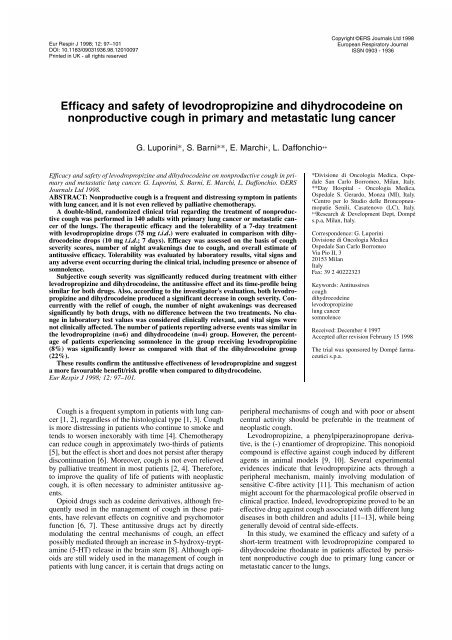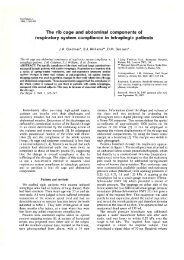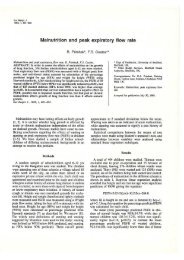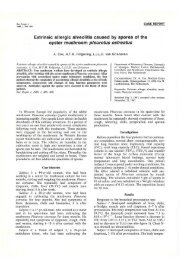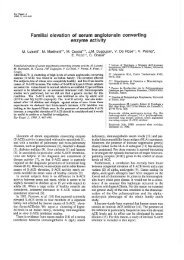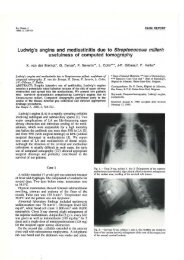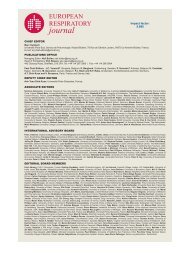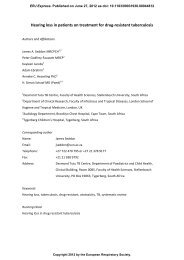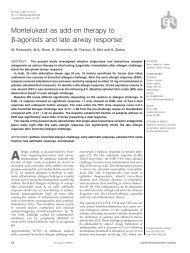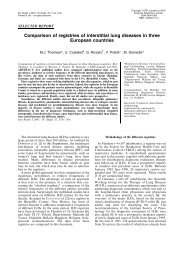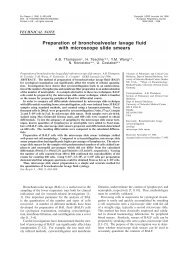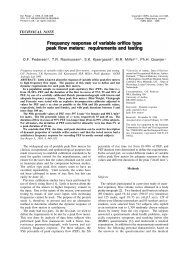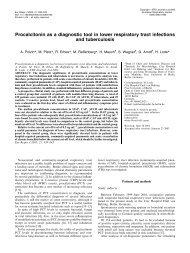Efficacy and safety of levodropropizine and dihydrocodeine on ...
Efficacy and safety of levodropropizine and dihydrocodeine on ...
Efficacy and safety of levodropropizine and dihydrocodeine on ...
Create successful ePaper yourself
Turn your PDF publications into a flip-book with our unique Google optimized e-Paper software.
Eur Respir J 1998; 12: 97–101<br />
DOI: 10.1183/09031936.98.12010097<br />
Printed in UK - all rights reserved<br />
Copyright ©ERS Journals Ltd 1998<br />
European Respiratory Journal<br />
ISSN 0903 - 1936<br />
<str<strong>on</strong>g>Efficacy</str<strong>on</strong>g> <str<strong>on</strong>g>and</str<strong>on</strong>g> <str<strong>on</strong>g>safety</str<strong>on</strong>g> <str<strong>on</strong>g>of</str<strong>on</strong>g> <str<strong>on</strong>g>levodropropizine</str<strong>on</strong>g> <str<strong>on</strong>g>and</str<strong>on</strong>g> <str<strong>on</strong>g>dihydrocodeine</str<strong>on</strong>g> <strong>on</strong><br />
n<strong>on</strong>productive cough in primary <str<strong>on</strong>g>and</str<strong>on</strong>g> metastatic lung cancer<br />
aa<br />
G. Luporini*, S. Barni**, E. Marchi +, L. Daff<strong>on</strong>chio ++<br />
<str<strong>on</strong>g>Efficacy</str<strong>on</strong>g> <str<strong>on</strong>g>and</str<strong>on</strong>g> <str<strong>on</strong>g>safety</str<strong>on</strong>g> <str<strong>on</strong>g>of</str<strong>on</strong>g> <str<strong>on</strong>g>levodropropizine</str<strong>on</strong>g> <str<strong>on</strong>g>and</str<strong>on</strong>g> <str<strong>on</strong>g>dihydrocodeine</str<strong>on</strong>g> <strong>on</strong> n<strong>on</strong>productive cough in primary<br />
<str<strong>on</strong>g>and</str<strong>on</strong>g> metastatic lung cancer. G. Luporini, S. Barni, E. Marchi, L. Daff<strong>on</strong>chio. ©ERS<br />
Journals Ltd 1998.<br />
ABSTRACT: N<strong>on</strong>productive cough is a frequent <str<strong>on</strong>g>and</str<strong>on</strong>g> distressing symptom in patients<br />
with lung cancer, <str<strong>on</strong>g>and</str<strong>on</strong>g> it is not even relieved by palliative chemotherapy.<br />
A double-blind, r<str<strong>on</strong>g>and</str<strong>on</strong>g>omized clinical trial regarding the treatment <str<strong>on</strong>g>of</str<strong>on</strong>g> n<strong>on</strong>productive<br />
cough was performed in 140 adults with primary lung cancer or metastatic cancer<br />
<str<strong>on</strong>g>of</str<strong>on</strong>g> the lungs. The therapeutic efficacy <str<strong>on</strong>g>and</str<strong>on</strong>g> the tolerability <str<strong>on</strong>g>of</str<strong>on</strong>g> a 7-day treatment<br />
with <str<strong>on</strong>g>levodropropizine</str<strong>on</strong>g> drops (75 mg t.i.d.) were evaluated in comparis<strong>on</strong> with <str<strong>on</strong>g>dihydrocodeine</str<strong>on</strong>g><br />
drops (10 mg t.i.d.; 7 days). <str<strong>on</strong>g>Efficacy</str<strong>on</strong>g> was assessed <strong>on</strong> the basis <str<strong>on</strong>g>of</str<strong>on</strong>g> cough<br />
severity scores, number <str<strong>on</strong>g>of</str<strong>on</strong>g> night awakenings due to cough, <str<strong>on</strong>g>and</str<strong>on</strong>g> overall estimate <str<strong>on</strong>g>of</str<strong>on</strong>g><br />
antitussive efficacy. Tolerability was evaluated by laboratory results, vital signs <str<strong>on</strong>g>and</str<strong>on</strong>g><br />
any adverse event occurring during the clinical trial, including presence or absence <str<strong>on</strong>g>of</str<strong>on</strong>g><br />
somnolence.<br />
Subjective cough severity was significantly reduced during treatment with either<br />
<str<strong>on</strong>g>levodropropizine</str<strong>on</strong>g> <str<strong>on</strong>g>and</str<strong>on</strong>g> <str<strong>on</strong>g>dihydrocodeine</str<strong>on</strong>g>, the antitussive effect <str<strong>on</strong>g>and</str<strong>on</strong>g> its time-pr<str<strong>on</strong>g>of</str<strong>on</strong>g>ile being<br />
similar for both drugs. Also, according to the investigator's evaluati<strong>on</strong>, both <str<strong>on</strong>g>levodropropizine</str<strong>on</strong>g><br />
<str<strong>on</strong>g>and</str<strong>on</strong>g> <str<strong>on</strong>g>dihydrocodeine</str<strong>on</strong>g> produced a significant decrease in cough severity. C<strong>on</strong>currently<br />
with the relief <str<strong>on</strong>g>of</str<strong>on</strong>g> cough, the number <str<strong>on</strong>g>of</str<strong>on</strong>g> night awakenings was decreased<br />
significantly by both drugs, with no difference between the two treatments. No change<br />
in laboratory test values was c<strong>on</strong>sidered clinically relevant, <str<strong>on</strong>g>and</str<strong>on</strong>g> vital signs were<br />
not clinically affected. The number <str<strong>on</strong>g>of</str<strong>on</strong>g> patients reporting adverse events was similar in<br />
the <str<strong>on</strong>g>levodropropizine</str<strong>on</strong>g> (n=6) <str<strong>on</strong>g>and</str<strong>on</strong>g> <str<strong>on</strong>g>dihydrocodeine</str<strong>on</strong>g> (n=4) group. However, the percentage<br />
<str<strong>on</strong>g>of</str<strong>on</strong>g> patients experiencing somnolence in the group receiving <str<strong>on</strong>g>levodropropizine</str<strong>on</strong>g><br />
(8%) was significantly lower as compared with that <str<strong>on</strong>g>of</str<strong>on</strong>g> the <str<strong>on</strong>g>dihydrocodeine</str<strong>on</strong>g> group<br />
(22%).<br />
These results c<strong>on</strong>firm the antitussive effectiveness <str<strong>on</strong>g>of</str<strong>on</strong>g> <str<strong>on</strong>g>levodropropizine</str<strong>on</strong>g> <str<strong>on</strong>g>and</str<strong>on</strong>g> suggest<br />
a more favourable benefit/risk pr<str<strong>on</strong>g>of</str<strong>on</strong>g>ile when compared to <str<strong>on</strong>g>dihydrocodeine</str<strong>on</strong>g>.<br />
Eur Respir J 1998; 12: 97–101.<br />
Cough is a frequent symptom in patients with lung cancer<br />
[1, 2], regardless <str<strong>on</strong>g>of</str<strong>on</strong>g> the histological type [1, 3]. Cough<br />
is more distressing in patients who c<strong>on</strong>tinue to smoke <str<strong>on</strong>g>and</str<strong>on</strong>g><br />
tends to worsen inexorably with time [4]. Chemotherapy<br />
can reduce cough in approximately two-thirds <str<strong>on</strong>g>of</str<strong>on</strong>g> patients<br />
[5], but the effect is short <str<strong>on</strong>g>and</str<strong>on</strong>g> does not persist after therapy<br />
disc<strong>on</strong>tinuati<strong>on</strong> [6]. Moreover, cough is not even relieved<br />
by palliative treatment in most patients [2, 4]. Therefore,<br />
to improve the quality <str<strong>on</strong>g>of</str<strong>on</strong>g> life <str<strong>on</strong>g>of</str<strong>on</strong>g> patients with neoplastic<br />
cough, it is <str<strong>on</strong>g>of</str<strong>on</strong>g>ten necessary to administer antitussive agents.<br />
Opioid drugs such as codeine derivatives, although frequently<br />
used in the management <str<strong>on</strong>g>of</str<strong>on</strong>g> cough in these patients,<br />
have relevant effects <strong>on</strong> cognitive <str<strong>on</strong>g>and</str<strong>on</strong>g> psychomotor<br />
functi<strong>on</strong> [6, 7]. These antitussive drugs act by directly<br />
modulating the central mechanisms <str<strong>on</strong>g>of</str<strong>on</strong>g> cough, an effect<br />
possibly mediated through an increase in 5-hydroxy-tryptamine<br />
(5-HT) release in the brain stem [8]. Although opioids<br />
are still widely used in the management <str<strong>on</strong>g>of</str<strong>on</strong>g> cough in<br />
patients with lung cancer, it is certain that drugs acting <strong>on</strong><br />
*Divisi<strong>on</strong>e di Oncologia Medica, Ospedale<br />
San Carlo Borromeo, Milan, Italy.<br />
**Day Hospital - Oncologia Medica,<br />
Ospedale S. Gerardo, M<strong>on</strong>za (MI), Italy.<br />
+ Centro per lo Studio delle Br<strong>on</strong>copneumopatie<br />
Senili, Casatenovo (LC), Italy.<br />
++ Research & Development Dept, Dompé<br />
s.p.a, Milan, Italy.<br />
Corresp<strong>on</strong>dence: G. Luporini<br />
Divisi<strong>on</strong>e di Oncologia Medica<br />
Ospedale San Carlo Borromeo<br />
Via Pio II, 3<br />
20153 Milan<br />
Italy<br />
Fax: 39 2 40222323<br />
Keywords: Antitussives<br />
cough<br />
<str<strong>on</strong>g>dihydrocodeine</str<strong>on</strong>g><br />
<str<strong>on</strong>g>levodropropizine</str<strong>on</strong>g><br />
lung cancer<br />
somnolence<br />
Received: December 4 1997<br />
Accepted after revisi<strong>on</strong> February 15 1998<br />
The trial was sp<strong>on</strong>sored by Dompé farmaceutici<br />
s.p.a.<br />
peripheral mechanisms <str<strong>on</strong>g>of</str<strong>on</strong>g> cough <str<strong>on</strong>g>and</str<strong>on</strong>g> with poor or absent<br />
central activity should be preferable in the treatment <str<strong>on</strong>g>of</str<strong>on</strong>g><br />
neoplastic cough.<br />
Levodropropizine, a phenylpiperazinopropane derivative,<br />
is the (-) enantiomer <str<strong>on</strong>g>of</str<strong>on</strong>g> dropropizine. This n<strong>on</strong>opioid<br />
compound is effective against cough induced by different<br />
agents in animal models [9, 10]. Several experimental<br />
evidences indicate that <str<strong>on</strong>g>levodropropizine</str<strong>on</strong>g> acts through a<br />
peripheral mechanism, mainly involving modulati<strong>on</strong> <str<strong>on</strong>g>of</str<strong>on</strong>g><br />
sensitive C-fibre activity [11]. This mechanism <str<strong>on</strong>g>of</str<strong>on</strong>g> acti<strong>on</strong><br />
might account for the pharmacological pr<str<strong>on</strong>g>of</str<strong>on</strong>g>ile observed in<br />
clinical practice. Indeed, <str<strong>on</strong>g>levodropropizine</str<strong>on</strong>g> proved to be an<br />
effective drug against cough associated with different lung<br />
diseases in both children <str<strong>on</strong>g>and</str<strong>on</strong>g> adults [11–13], while being<br />
generally devoid <str<strong>on</strong>g>of</str<strong>on</strong>g> central side-effects.<br />
In this study, we examined the efficacy <str<strong>on</strong>g>and</str<strong>on</strong>g> <str<strong>on</strong>g>safety</str<strong>on</strong>g> <str<strong>on</strong>g>of</str<strong>on</strong>g> a<br />
short-term treatment with <str<strong>on</strong>g>levodropropizine</str<strong>on</strong>g> compared to<br />
<str<strong>on</strong>g>dihydrocodeine</str<strong>on</strong>g> rhodanate in patients affected by persistent<br />
n<strong>on</strong>productive cough due to primary lung cancer or<br />
metastatic cancer to the lungs.
98 G. LUPORINI ET AL.<br />
Populati<strong>on</strong><br />
Methods<br />
We selected in- <str<strong>on</strong>g>and</str<strong>on</strong>g> outpatients <str<strong>on</strong>g>of</str<strong>on</strong>g> either sex older than<br />
18 yrs, with a diagnosis <str<strong>on</strong>g>of</str<strong>on</strong>g> unilateral or bilateral, primary<br />
lung cancer or metastatic cancer to the lungs. Patients with<br />
a documented history <str<strong>on</strong>g>of</str<strong>on</strong>g> lung cancer who developed persistent,<br />
n<strong>on</strong>productive cough were enrolled if they dem<strong>on</strong>strated<br />
at least 5 coughs·h -1.<br />
Exclusi<strong>on</strong> criteria were: presence <str<strong>on</strong>g>of</str<strong>on</strong>g> productive cough;<br />
presence <str<strong>on</strong>g>of</str<strong>on</strong>g> other diseases causing cough such as br<strong>on</strong>chial<br />
asthma, br<strong>on</strong>chiectasis, tuberculosis, heart failure; <str<strong>on</strong>g>and</str<strong>on</strong>g><br />
treatment with other antitussives, angiotensin-c<strong>on</strong>verting<br />
enzyme (ACE) inhibitors, antihistamines, systemic sedatives,<br />
or mucoactive drugs.<br />
The study was c<strong>on</strong>ducted in agreement with the European<br />
Ec<strong>on</strong>omic Community (EEC) Guideline <strong>on</strong> Good<br />
Clinical Practice (GCP), <str<strong>on</strong>g>and</str<strong>on</strong>g> the protocol was approved by<br />
an independent Regi<strong>on</strong>al Ethics Committee <str<strong>on</strong>g>and</str<strong>on</strong>g> by the<br />
Local Ethics Authority <str<strong>on</strong>g>of</str<strong>on</strong>g> each hospital. Before enrolment,<br />
signed or witnessed informed c<strong>on</strong>sent to participate into<br />
the study was obtained by each patient.<br />
Study design<br />
We c<strong>on</strong>ducted a multicentre, parallel group, doubleblind<br />
study. After the preliminary evaluati<strong>on</strong>, patients were<br />
r<str<strong>on</strong>g>and</str<strong>on</strong>g>omized to treatment with <str<strong>on</strong>g>levodropropizine</str<strong>on</strong>g> (Levotuss®,<br />
Dompé Farmaceutica, Milan, Italy, 6% oral drops) or <str<strong>on</strong>g>dihydrocodeine</str<strong>on</strong>g><br />
rhodanate (Paracodina®, Knoll Farmaceutica,<br />
Milan, Italy, 1% oral drops). Daily administered doses<br />
were equal to 75 mg (25 drops) t.i.d. <str<strong>on</strong>g>of</str<strong>on</strong>g> <str<strong>on</strong>g>levodropropizine</str<strong>on</strong>g><br />
<str<strong>on</strong>g>and</str<strong>on</strong>g> 10 mg (25 drops) t.i.d. <str<strong>on</strong>g>of</str<strong>on</strong>g> <str<strong>on</strong>g>dihydrocodeine</str<strong>on</strong>g>. Each dose<br />
was scheduled at 6 h to 8 h intervals (between 07:00 <str<strong>on</strong>g>and</str<strong>on</strong>g><br />
09:00 h, at 15:00 h <str<strong>on</strong>g>and</str<strong>on</strong>g> between 21:00 <str<strong>on</strong>g>and</str<strong>on</strong>g> 23:00 h). The<br />
dose <str<strong>on</strong>g>of</str<strong>on</strong>g> <str<strong>on</strong>g>dihydrocodeine</str<strong>on</strong>g> (10 mg t.i.d.) was set <strong>on</strong> the basis<br />
<str<strong>on</strong>g>of</str<strong>on</strong>g> the therapeutic recommended daily dosage. To keep the<br />
two treatments indistinguishable as per the number <str<strong>on</strong>g>of</str<strong>on</strong>g><br />
drops dispensed, the dose <str<strong>on</strong>g>of</str<strong>on</strong>g> <str<strong>on</strong>g>levodropropizine</str<strong>on</strong>g> (75 mg<br />
t.i.d.) was slightly higher than the recommended dose (60<br />
mg t.i.d.). Treatments were administered for 7 days, a period<br />
that allowed sufficiently accurate estimate <str<strong>on</strong>g>of</str<strong>on</strong>g> drug efficacy<br />
in patients with such severe disease.<br />
<str<strong>on</strong>g>Efficacy</str<strong>on</strong>g><br />
<str<strong>on</strong>g>Efficacy</str<strong>on</strong>g> was assessed <strong>on</strong> the basis <str<strong>on</strong>g>of</str<strong>on</strong>g> cough severity<br />
graded by both the patients <str<strong>on</strong>g>and</str<strong>on</strong>g> the investigators according<br />
to the following five-point scale: 1 for absent (0–1<br />
cough·h -1); 2 for mild (2–4 coughs·h -1); 3 for moderate (5–<br />
10 coughs·h -1); 4 for severe (11–20 coughs·h -1); <str<strong>on</strong>g>and</str<strong>on</strong>g> 5 for<br />
very severe (>20 coughs·h -1) cough. In particular, the<br />
number <str<strong>on</strong>g>of</str<strong>on</strong>g> coughs was recorded by the patient for five<br />
c<strong>on</strong>secutive hours, either immediately after the first or<br />
sec<strong>on</strong>d daily dose, <str<strong>on</strong>g>and</str<strong>on</strong>g> by the investigator after observing<br />
the patients for 15 min. The cough severity was evaluated<br />
at baseline, <str<strong>on</strong>g>and</str<strong>on</strong>g> <strong>on</strong> days 1, 3 <str<strong>on</strong>g>and</str<strong>on</strong>g> 7 during treatment. Patients<br />
also recorded the number <str<strong>on</strong>g>of</str<strong>on</strong>g> night awakenings due to<br />
cough before treatment <str<strong>on</strong>g>and</str<strong>on</strong>g> <strong>on</strong> days 1, 3 <str<strong>on</strong>g>and</str<strong>on</strong>g> 7 during<br />
treatment.<br />
At the end <str<strong>on</strong>g>of</str<strong>on</strong>g> the 7-day treatment, about two-thirds <str<strong>on</strong>g>of</str<strong>on</strong>g><br />
the patients <str<strong>on</strong>g>and</str<strong>on</strong>g> their investigators were asked to give an<br />
overall estimate <str<strong>on</strong>g>of</str<strong>on</strong>g> the antitussive efficacy <str<strong>on</strong>g>of</str<strong>on</strong>g> the treatment<br />
according to the following four-point scale: worsening <str<strong>on</strong>g>of</str<strong>on</strong>g><br />
cough; no change in cough; improvement <str<strong>on</strong>g>of</str<strong>on</strong>g> cough; <str<strong>on</strong>g>and</str<strong>on</strong>g><br />
disappearance <str<strong>on</strong>g>of</str<strong>on</strong>g> cough.<br />
Safety<br />
The primary variable for <str<strong>on</strong>g>safety</str<strong>on</strong>g> was the presence <str<strong>on</strong>g>of</str<strong>on</strong>g><br />
somnolence, defined as a decrease <str<strong>on</strong>g>of</str<strong>on</strong>g> the waking status<br />
during the day <str<strong>on</strong>g>and</str<strong>on</strong>g> m<strong>on</strong>itored by specific questi<strong>on</strong>ing (no<br />
daytime somnolence; mild daytime somnolence; <str<strong>on</strong>g>and</str<strong>on</strong>g> severe<br />
daytime somnolence).<br />
The sec<strong>on</strong>dary variables for <str<strong>on</strong>g>safety</str<strong>on</strong>g> were data <strong>on</strong> haematology,<br />
blood chemistry, urinalysis, blood pressure <str<strong>on</strong>g>and</str<strong>on</strong>g><br />
heart rate, recorded before entry <str<strong>on</strong>g>and</str<strong>on</strong>g> at the end <str<strong>on</strong>g>of</str<strong>on</strong>g> treatment.<br />
Any adverse event was also recorded throughout the<br />
study period.<br />
Statistical analysis<br />
The appropriate descriptive statistics were performed<br />
<strong>on</strong> all collected variables to describe the sample. To ensure<br />
homogeneity between the two treatment groups, a χ 2<br />
test or Student's t-test was applied.<br />
Cough severity <str<strong>on</strong>g>and</str<strong>on</strong>g> the number <str<strong>on</strong>g>of</str<strong>on</strong>g> awakenings at night<br />
were analysed by ANOVA (split-plot model). For the latter<br />
parameter, <strong>on</strong>ly data from patients with at least <strong>on</strong>e<br />
wakeup at baseline were c<strong>on</strong>sidered. The presence <str<strong>on</strong>g>of</str<strong>on</strong>g> somnolence<br />
was analysed by the χ 2 test. Missing data were<br />
processed as such, since no replacement <str<strong>on</strong>g>of</str<strong>on</strong>g> the missing<br />
values was c<strong>on</strong>sidered appropriate without introducing a<br />
bias in the treatment evaluati<strong>on</strong>. All data were analysed<br />
according to intenti<strong>on</strong>-to-treat criteria (all patients r<str<strong>on</strong>g>and</str<strong>on</strong>g>omized),<br />
except for results <strong>on</strong> somnolence, which were<br />
also analysed according to per-protocol criteria (<strong>on</strong>ly patients<br />
compliant with major protocol procedures).<br />
Results<br />
A group <str<strong>on</strong>g>of</str<strong>on</strong>g> 140 patients was enrolled in the study: 69<br />
patients were r<str<strong>on</strong>g>and</str<strong>on</strong>g>omized to <str<strong>on</strong>g>levodropropizine</str<strong>on</strong>g> <str<strong>on</strong>g>and</str<strong>on</strong>g> 71 to<br />
<str<strong>on</strong>g>dihydrocodeine</str<strong>on</strong>g>. Two patients in each group did not take<br />
any study medicati<strong>on</strong>; five other patients in the <str<strong>on</strong>g>levodropropizine</str<strong>on</strong>g><br />
group <str<strong>on</strong>g>and</str<strong>on</strong>g> three patients in the <str<strong>on</strong>g>dihydrocodeine</str<strong>on</strong>g><br />
group were withdrawn before 6 days <str<strong>on</strong>g>of</str<strong>on</strong>g> treatment. One<br />
patient r<str<strong>on</strong>g>and</str<strong>on</strong>g>omized to <str<strong>on</strong>g>levodropropizine</str<strong>on</strong>g> (mammary carcinoma<br />
with mediastinal metastasis) <str<strong>on</strong>g>and</str<strong>on</strong>g> three patients r<str<strong>on</strong>g>and</str<strong>on</strong>g>omized<br />
to <str<strong>on</strong>g>dihydrocodeine</str<strong>on</strong>g> (two pleural mesothelioma,<br />
<strong>on</strong>e mammary carcinoma with b<strong>on</strong>e metastasis <str<strong>on</strong>g>and</str<strong>on</strong>g> lymphangitis)<br />
were included in the deviati<strong>on</strong> <str<strong>on</strong>g>of</str<strong>on</strong>g> inclusi<strong>on</strong> criteria<br />
for underlying pathology. All these patients were<br />
excluded from the per-protocol analysis. Patients' characteristics<br />
at baseline are shown in table 1. More males than<br />
females were included, as expected, in agreement with the<br />
prevalence <str<strong>on</strong>g>of</str<strong>on</strong>g> lung cancer. Most <str<strong>on</strong>g>of</str<strong>on</strong>g> the patients within<br />
both <str<strong>on</strong>g>levodropropizine</str<strong>on</strong>g> <str<strong>on</strong>g>and</str<strong>on</strong>g> <str<strong>on</strong>g>dihydrocodeine</str<strong>on</strong>g> groups (between<br />
70–80%) were affected by primary lung cancer,<br />
including small <str<strong>on</strong>g>and</str<strong>on</strong>g> n<strong>on</strong>small cell lung cancer. The two<br />
treatment groups were homogeneous as regards to all
Table 1. – Demographic <str<strong>on</strong>g>and</str<strong>on</strong>g> baseline characteristics<br />
Parameter Levodrop.<br />
mean±SD<br />
Patient n<br />
Sex M/F n (%)<br />
Age yrs<br />
Weight kg<br />
Height cm<br />
Smokers n (%)<br />
Underlying pathology n (%)<br />
Primary lung cancer<br />
Metastatic cancer to the<br />
lungs<br />
Other<br />
Neoplastic disease durati<strong>on</strong><br />
m<strong>on</strong>ths<br />
Surgical interventi<strong>on</strong> n (%)<br />
Cough symptom durati<strong>on</strong><br />
days<br />
Cough severity score<br />
Patient<br />
Investigator<br />
Night awakenings<br />
69<br />
59/10<br />
(85.5/14.5)<br />
62±9<br />
67±11<br />
167±7<br />
10 (14.5)<br />
54 (78)<br />
14 (20)<br />
1 (1)<br />
15.1±29.1<br />
20 (29)<br />
65.1±96.7<br />
3.7±0.6<br />
3.8±0.7<br />
1.4±1.9<br />
demographic data <str<strong>on</strong>g>and</str<strong>on</strong>g> baseline features, except for sex<br />
distributi<strong>on</strong> (p
100 G. LUPORINI ET AL.<br />
Presence <str<strong>on</strong>g>of</str<strong>on</strong>g> somnolence %<br />
30<br />
20<br />
10<br />
0<br />
Levodropropizine Dihydrocodeine<br />
Fig. 3. – Presence <str<strong>on</strong>g>of</str<strong>on</strong>g> somnolence. Values represent the percentage <str<strong>on</strong>g>of</str<strong>on</strong>g><br />
patients reporting somnolence within <str<strong>on</strong>g>levodropropizine</str<strong>on</strong>g> ( ) <str<strong>on</strong>g>and</str<strong>on</strong>g><br />
<str<strong>on</strong>g>dihydrocodeine</str<strong>on</strong>g> ( ) group (intenti<strong>on</strong>-to-treat analysis). The percentage<br />
<str<strong>on</strong>g>of</str<strong>on</strong>g> patients reporting somnolence during the <str<strong>on</strong>g>dihydrocodeine</str<strong>on</strong>g> treatment<br />
was significantly higher (*: p
egard, it should be noted that additi<strong>on</strong>al treatments required<br />
by patients <str<strong>on</strong>g>and</str<strong>on</strong>g> known to cause somnolence were<br />
equally distributed in both groups. Since side-effects were<br />
similar <str<strong>on</strong>g>and</str<strong>on</strong>g> trivial in both treatment groups, the results <strong>on</strong><br />
somnolence are in favour <str<strong>on</strong>g>of</str<strong>on</strong>g> a better tolerability <str<strong>on</strong>g>of</str<strong>on</strong>g> <str<strong>on</strong>g>levodropropizine</str<strong>on</strong>g><br />
in these patients. Indeed, a few patients treated<br />
with <str<strong>on</strong>g>levodropropizine</str<strong>on</strong>g> reported the occurrence <str<strong>on</strong>g>of</str<strong>on</strong>g><br />
somnolence, which may simply reflect either a deteriorati<strong>on</strong><br />
in the general c<strong>on</strong>diti<strong>on</strong>s <str<strong>on</strong>g>of</str<strong>on</strong>g> the patients or the effect <str<strong>on</strong>g>of</str<strong>on</strong>g><br />
additi<strong>on</strong>al therapy rather than an effect due to drug intake.<br />
Mechanisms <str<strong>on</strong>g>of</str<strong>on</strong>g> n<strong>on</strong>productive cough associated to lung<br />
cancer likely involve activati<strong>on</strong> <str<strong>on</strong>g>of</str<strong>on</strong>g> n<strong>on</strong>-myelinated Cfibres<br />
through the mechanical distorti<strong>on</strong> <str<strong>on</strong>g>of</str<strong>on</strong>g> br<strong>on</strong>chial airways<br />
<str<strong>on</strong>g>and</str<strong>on</strong>g>/or through the acti<strong>on</strong> <str<strong>on</strong>g>of</str<strong>on</strong>g> bradykinin. In additi<strong>on</strong>,<br />
tachykinines released from C-fibres are able to activate<br />
rapidly adapting receptors [18]. Indeed, bradykinin is comm<strong>on</strong>ly<br />
released by neoplastic cells [19] <str<strong>on</strong>g>and</str<strong>on</strong>g> neoplastic<br />
cough can be reduced by inhaled crom<strong>on</strong>es through a<br />
blocking effect <str<strong>on</strong>g>of</str<strong>on</strong>g> bradykinin activity <strong>on</strong> C-fibres [20]. The<br />
effect <str<strong>on</strong>g>of</str<strong>on</strong>g> <str<strong>on</strong>g>dihydrocodeine</str<strong>on</strong>g> seems to be mediated by an increase<br />
in 5-HT release in the brain stem [8], whereas the<br />
antitussive activity <str<strong>on</strong>g>of</str<strong>on</strong>g> <str<strong>on</strong>g>levodropropizine</str<strong>on</strong>g> is likely due to<br />
peripheral modulati<strong>on</strong> <str<strong>on</strong>g>of</str<strong>on</strong>g> cough receptor activity. This<br />
effect seems, at least in part, to be mediated by an interference<br />
with the neuropeptide system [11]. This hypothesis<br />
is supported by the findings that <str<strong>on</strong>g>levodropropizine</str<strong>on</strong>g> blocks<br />
cough induced in animals [10] <str<strong>on</strong>g>and</str<strong>on</strong>g> humans [21] by capsaicin,<br />
a well-known <str<strong>on</strong>g>and</str<strong>on</strong>g> selective stimulant for C-fibres.<br />
Moreover, <str<strong>on</strong>g>levodropropizine</str<strong>on</strong>g> inhibits afferent C-fibre firing<br />
in anaesthetized cats [22] <str<strong>on</strong>g>and</str<strong>on</strong>g> neuropeptide release from<br />
pulm<strong>on</strong>ary C-fibres in isolated guinea-pig lungs [23].<br />
Thus, it is possible that this mechanism might account<br />
also for the effectiveness <str<strong>on</strong>g>of</str<strong>on</strong>g> <str<strong>on</strong>g>levodropropizine</str<strong>on</strong>g> against<br />
cough in pat-ients with lung cancer.<br />
In c<strong>on</strong>clusi<strong>on</strong>, this study dem<strong>on</strong>strated that <str<strong>on</strong>g>levodropropizine</str<strong>on</strong>g><br />
<str<strong>on</strong>g>and</str<strong>on</strong>g> <str<strong>on</strong>g>dihydrocodeine</str<strong>on</strong>g> were equally effective in relieving<br />
n<strong>on</strong>productive cough in most patients with primary<br />
lung cancer or metastatic cancer to the lungs. Side-effects<br />
were also comparable, with the excepti<strong>on</strong> <str<strong>on</strong>g>of</str<strong>on</strong>g> somnolence<br />
that was reported less frequently during <str<strong>on</strong>g>levodropropizine</str<strong>on</strong>g><br />
than during <str<strong>on</strong>g>dihydrocodeine</str<strong>on</strong>g> treatment.<br />
Participating investigators: G. Luporini, M. Clerici, Divisi<strong>on</strong>e<br />
di Oncologia Medica, Ospedale S. Carlo Borromeo, Milano;<br />
E. Marchi, Centro per lo Studio delle Br<strong>on</strong>copneumopatie<br />
Senili, Casatenovo (LC); R. Labianca, G. Beretta, Sezi<strong>on</strong>e di<br />
Oncologia Medica, Ospedale E. Bassini, Cinisello Balsamo<br />
(MI); S. Barni, Day Hospital - Oncologia Medica, Ospedale S.<br />
Gerardo, M<strong>on</strong>za (MI); E. Soresi, Divisi<strong>on</strong>e di Fisiopatologia<br />
Respiratoria, Ospedale Niguarda Ca' Gr<str<strong>on</strong>g>and</str<strong>on</strong>g>a, Milano; R. Rimoldi,<br />
Divisi<strong>on</strong>e di Pneumologia, Ospedale di Circolo, Varese; F.<br />
Berni, Divisi<strong>on</strong>e di Pneumologia, Ospedale S.ta Cor<strong>on</strong>a, Garbagnate<br />
(MI); E. Farina, Divisi<strong>on</strong>e di Pneumologia, Ospedale S.<br />
Salvatore, L'Aquila.<br />
References<br />
1. Sridhar KS, Bounassi MJ, Raub W Jr, et al. Clinical features<br />
<str<strong>on</strong>g>of</str<strong>on</strong>g> adenosquamous lung carcinoma in 127 patients.<br />
Am Rev Respir Dis 1990; 142: 19–23.<br />
2. An<strong>on</strong>ymous. A Medical Research Council (MRC) r<str<strong>on</strong>g>and</str<strong>on</strong>g>omised<br />
trial <str<strong>on</strong>g>of</str<strong>on</strong>g> palliative radiotherapy with two fracti<strong>on</strong>s<br />
or a single fracti<strong>on</strong> in patients with inoperable n<strong>on</strong>-smallcell<br />
lung cancer (NSCLC) <str<strong>on</strong>g>and</str<strong>on</strong>g> poor performance status.<br />
Medical Research Council Lung Cancer Working Party.<br />
Br J Cancer 1992; 65: 934–941.<br />
3. Hopwood P, Stephens RJ. Symptoms at presentati<strong>on</strong> for<br />
treatment in patients with lung cancer: implicati<strong>on</strong>s for<br />
the evaluati<strong>on</strong> <str<strong>on</strong>g>of</str<strong>on</strong>g> palliative treatment. The Medical Rese-<br />
LEVODROPROPIZINE IN COUGH DUE TO LUNG CANCER 101<br />
arch Council (MRC) Lung Cancer Working Party. Br J<br />
Cancer 1995; 71: 633–636.<br />
4. Muers MF, Round CE. Palliati<strong>on</strong> <str<strong>on</strong>g>of</str<strong>on</strong>g> symptoms in n<strong>on</strong>small<br />
cell lung cancer: a study by the Yorkshire Regi<strong>on</strong>al<br />
Cancer Organisati<strong>on</strong> Thoracic Group. Thorax 1993; 48:<br />
339–343.<br />
5. Gollins SW, Burt PA, Barber PV, et al. High dose rate<br />
intraluminal radiotherapy for carcinoma <str<strong>on</strong>g>of</str<strong>on</strong>g> the br<strong>on</strong>chus:<br />
outcome <str<strong>on</strong>g>of</str<strong>on</strong>g> treatment <str<strong>on</strong>g>of</str<strong>on</strong>g> 406 patients. Radiother Oncol<br />
1994; 33: 31–40.<br />
6. Braga PC, Allegra L. Centrally acting opioid drugs. In:<br />
Braga PC, Allegra L, eds. Cough. New York, Raven<br />
Press, 1989; pp. 109–140.<br />
7. O'Neil WM. The cognitive <str<strong>on</strong>g>and</str<strong>on</strong>g> psychomotor effects <str<strong>on</strong>g>of</str<strong>on</strong>g><br />
opioid drugs in cancer pain management. Cancer Surv<br />
1994; 21: 67–84.<br />
8. Kamei J, Mori T, Igarashi H, et al. Serot<strong>on</strong>in release in<br />
nucleus <str<strong>on</strong>g>of</str<strong>on</strong>g> the solitary tract <str<strong>on</strong>g>and</str<strong>on</strong>g> its modulati<strong>on</strong> by antitussive<br />
drugs. Res Commun Chem Pathol Pharmacol 1992;<br />
76: 371–374.<br />
9. Munt PL, Clavenna G, Algate DR, et al. Antitussive<br />
effects <str<strong>on</strong>g>of</str<strong>on</strong>g> <str<strong>on</strong>g>levodropropizine</str<strong>on</strong>g> in the dog. Arzneim-Forsch<br />
Drug Res 1994; 44: 153–155.<br />
10. Mal<str<strong>on</strong>g>and</str<strong>on</strong>g>rino S, Melillo G, Bestetti A, et al. Antitussive<br />
properties <str<strong>on</strong>g>of</str<strong>on</strong>g> <str<strong>on</strong>g>levodropropizine</str<strong>on</strong>g>. Arzneim-Forsch Drug Res<br />
1988; 38: 1144–1150.<br />
11. Daff<strong>on</strong>chio L, Clavenna G, Fedele G, et al. Levodropropizine.<br />
Drugs Today 1995; 31: 299–305.<br />
12. Guffanti EE. Drugs with direct peripheral acti<strong>on</strong>. In:<br />
Braga PC, Allegra L, eds. Cough. New York, Raven<br />
Press, 1989; pp. 198–214.<br />
13. B<str<strong>on</strong>g>and</str<strong>on</strong>g>erali G, Riva E, Fiocchi A, et al. <str<strong>on</strong>g>Efficacy</str<strong>on</strong>g> <str<strong>on</strong>g>and</str<strong>on</strong>g> tolerability<br />
<str<strong>on</strong>g>of</str<strong>on</strong>g> <str<strong>on</strong>g>levodropropizine</str<strong>on</strong>g> <str<strong>on</strong>g>and</str<strong>on</strong>g> dropropizine in children with<br />
n<strong>on</strong>-productive cough. J Int Med Res 1995; 23: 175–183.<br />
14. An<strong>on</strong>ymous. Inoperable n<strong>on</strong>-small cell lung cancer (NS-<br />
CLC): a Medical Research Council r<str<strong>on</strong>g>and</str<strong>on</strong>g>omised trial <str<strong>on</strong>g>of</str<strong>on</strong>g><br />
palliative radiotherapy with two fracti<strong>on</strong>s <str<strong>on</strong>g>of</str<strong>on</strong>g> ten fracti<strong>on</strong>s.<br />
Report to the Medical Research Council by its Lung Cancer<br />
Working Party. Br J Cancer 1991; 63: 265–270.<br />
15. Bergman B, Aar<strong>on</strong>s<strong>on</strong> NK, Ahmedzai S, et al. The<br />
EORTC QLQ-LC13: a modular supplement to the EORTC<br />
Core Quality <str<strong>on</strong>g>of</str<strong>on</strong>g> Life Questi<strong>on</strong>naire (QLQ-C30) for use in<br />
lung cancer clinical trials. EORTC Study Group <strong>on</strong> Quality<br />
<str<strong>on</strong>g>of</str<strong>on</strong>g> Life. Eur J Cancer 1994; 30A: 635–642.<br />
16. Bleehen NM, Girling DJ, Machin D, et al. A r<str<strong>on</strong>g>and</str<strong>on</strong>g>omised<br />
trial <str<strong>on</strong>g>of</str<strong>on</strong>g> three or six courses <str<strong>on</strong>g>of</str<strong>on</strong>g> etoposide cyclophosphamide<br />
methotrexate <str<strong>on</strong>g>and</str<strong>on</strong>g> vincristine or six courses <str<strong>on</strong>g>of</str<strong>on</strong>g> etoposide<br />
<str<strong>on</strong>g>and</str<strong>on</strong>g> ifosfamide in small cell lung cancer (SCLC). II:<br />
Quality <str<strong>on</strong>g>of</str<strong>on</strong>g> life. Medical Research Council Lung Cancer<br />
Working Party. Br J Cancer 1993; 68: 1157–1166.<br />
17. Matthys H, Erhardt J, Ruhle KH. Objektivierung der<br />
wirkung v<strong>on</strong> antitussiva mittels tussometrie an patienten<br />
mit chr<strong>on</strong>ischem husten. Schweiz Med Wochrnschr 1985;<br />
115(9): 307–311.<br />
18. Kaufman MP, Coleridge KIM, Coleridge JC, et al. Bradykinin<br />
stimulates afferent vagal C-fibers in intrapulm<strong>on</strong>ary<br />
airways <str<strong>on</strong>g>of</str<strong>on</strong>g> dogs. J Appl Physiol 1980; 48: 511–517.<br />
19. Bunn PAJ, Chan D, Dienhart DG, et al. Neuropeptide signal<br />
transducti<strong>on</strong> in lung cancer clinical implicati<strong>on</strong>s <str<strong>on</strong>g>of</str<strong>on</strong>g><br />
bradykinin sensitivity <str<strong>on</strong>g>and</str<strong>on</strong>g> overall heterogeneity. Cancer<br />
Res 1992; 52: 24–31.<br />
20. Mor<strong>on</strong>i M, Porta C, Gualtieri G, et al. Inhaled sodium<br />
cromoglycate to treat cough in advanced lung cancer patients.<br />
Br J Cancer 1996; 74: 309–311.<br />
21. Mistretta A, Privitera S, Pulvirenti G, et al. Protective<br />
effect <str<strong>on</strong>g>of</str<strong>on</strong>g> <str<strong>on</strong>g>levodropropizine</str<strong>on</strong>g> against capsaicin-induced cough<br />
in allergic patients: a double-blind, placebo-c<strong>on</strong>trolled<br />
study. Adv Ther 1992; 9: 98–106.<br />
22. Shams H, Daff<strong>on</strong>chio L, Scheid P. Effects <str<strong>on</strong>g>of</str<strong>on</strong>g> <str<strong>on</strong>g>levodropropizine</str<strong>on</strong>g><br />
<strong>on</strong> vagal afferent C-fibres in the cat. Br J Pharmacol<br />
1996; 117: 853–858.<br />
23. Daff<strong>on</strong>chio L, Geppetti P, Javdan P, et al. Mechanism <str<strong>on</strong>g>of</str<strong>on</strong>g><br />
neuropeptide system inhibiti<strong>on</strong> in the lung: a study with<br />
<str<strong>on</strong>g>levodropropizine</str<strong>on</strong>g>. Pharmacol Res 1995; 31 (Suppl): 309.


